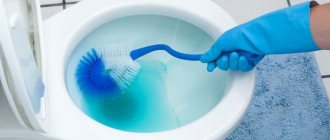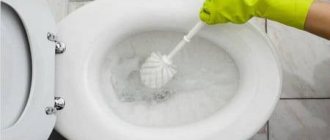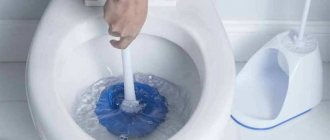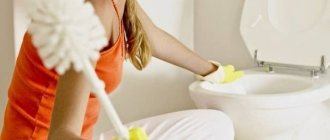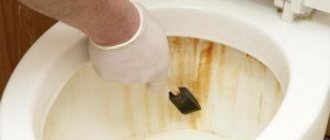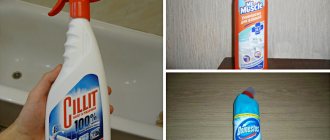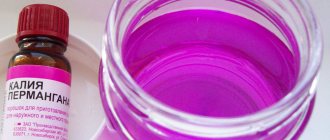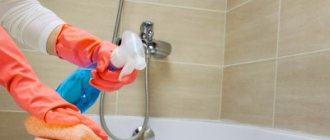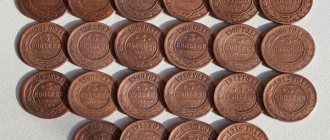One of the indicators of a well-kept apartment is a clean toilet. Unfortunately, colored spots appear on the walls of any plumbing fixture from time to time. In most cases, we are dealing with lime deposits, which are quite difficult to remove.
Agree, it is not advisable to replace a toilet because of its poor appearance, but it is also unpleasant to use a dirty toilet. There is only one option to solve the problem - choose an effective cleaning agent and prevent the appearance of old, difficult to remove stains. Don't know how to do this? We will help you understand these issues.
In the article, we described the most effective ways to combat pollution, listed how to clean the toilet from limescale, and also provided tips for keeping the bathroom clean.
Reasons for the formation of pollution
Before starting an active fight against different types of pollution, you need to determine the cause of their occurrence.
This will also help prevent re-contamination in the future and make it easier to maintain the plumbing.
There are three main reasons:
- Unsatisfactory condition of engineering communications. And we are not talking about old metal pipes inside the apartment, but about a common water main. Previously, pipes were made of galvanized metal, which began to corrode over time. Small fragments of oxidized iron entering the water color it and yellowish traces of rust form Also, the cause of rust formation can be an excessive amount of iron in tap water and a leaking toilet tank;
- Reason limescale formation is the presence of a large number of minerals and compounds in the water. As they settle on the surface of the toilet, they form a hard and durable coating of a grayish tint;
- Urine stones often form due to careless use of plumbing fixtures or as a result of a combination of the last two reasons. Especially often, urinary stone appears on the surface of the toilet in families where there are small children who do not yet know how to flush the toilet or do not do it completely. The plaque has a characteristic yellow-brown color. And if limescale is simply present on the surface, then urinary stone, consisting mainly of mineral substances, can emit an unpleasant odor. In addition, urinary stones contain many microbes.
Before we begin to consider various methods of removing contaminants, it is worth noting that only relatively fresh traces of rust, plaque or stone can be completely cleaned off . It is almost impossible to wash off old stains without mechanical cleaning. In turn, mechanical cleaning will lead to disruption of the integrity of the toilet bowl coating, the formation of characteristic marks and scratches. These places will be the most vulnerable and in the future, in the absence of regular care, it is on them that stains will form again. Therefore, in such an advanced case, it is still worth thinking about replacing the plumbing and not wasting effort and money on restoring it.
Limescale removers
Limescale is a hard deposit that cannot be washed off with gentle means.
Many housewives recommend using the following methods:
- No. 1. Cleaning with abrasive powders. It is really effective, since we affect the contamination with microscopic, but still solid particles of abrasive. At the same time, not only plaque, but also scratches are erased from the surface. As a result, areas that lack the characteristic shine may form on the surface of the once smooth and shiny toilet. This is the negative side of mechanical cleaning, which we have already mentioned, so its use is quite controversial;
- No. 2. Alkali-based compounds will help deal with plaque without harming the surface Products used to clear clogged sewer pipes are excellent. But there are some precautions here too. If your toilet is made of plastic, then it is better to refrain from this method, as well as from using compositions based on various acids. All alkaline products contain sodium hydroxide. It is he who breaks down the plaque. Simply pour the product into the toilet, close the lid and leave for several hours. After this, carefully go over the walls and problem areas with a brush. You can do it differently - scoop the water out of the drain hole, having first blocked the flow of water into the drain tank, apply the product to a piece of cloth and cover the area of contamination. This must be done with protective gloves and do not forget to ventilate the room. After a couple of hours, you need to rub the area, and then fill the tank and rinse with water;
- No. 3. A more aggressive agent is acid. You can use acetic acid. Simply pour the product into the toilet, close the lid and leave it to work overnight. The next day, thoroughly scrub the stain with a brush and flush the water several times. If you didn’t achieve the desired result the first time, you can try again;
- No. 4. Sometimes acetic acid remains powerless against persistent and old plaque. Then you can use a more aggressive acid - hydrochloric acid. However, this method is strictly contraindicated if your pipes are plastic. If they are made of metal or cast iron, you can act on plaque but no more than 1 time. 200 ml of 33% hydrochloric acid solution into a container with a convenient dispenser or spout . Very carefully, in a thin stream, distribute the acid over the entire surface of the toilet. Immediately close the lid and set aside for 20 minutes. After that, just flush the water several times. When working with this substance, you need to be extremely careful, protect your hands and preferably your respiratory and vision organs;
- №5 Plaque can also be treated sorrel or citric acid, if it has just begun to form on the surface. The acid is diluted in warm clean water in such a proportion as to ultimately obtain a solution of 5% concentration.
The liquid is applied to the stains for several hours, then rubbed with a brush and washed off; - No. 6. Chlorine products may have the desired effect. They are simply applied to the surface, left to act for several hours, and then cleaned with a brush or brush;
- №7. Unusual ways to combat limescale include exposure to carbonated drinks. More precisely, coca cola or sprite. The fact is that these drinks contain a large amount of citric acid.
Just pour cola into the toilet and leave it overnight. You will need 2-3 bottles. If a miracle does not happen, then the pollution is too persistent; - No. 8. In this case, you can try treating the surface with electrolyte. Surely there is a motorist in the family who has this solution. Pour 1 cup of liquid into the toilet, distributing it along the walls. Leave on for 15 minutes and then rinse with water. This method is also not recommended for use with plastic pipes;
- No. 9. Veterinary pharmacies sell a product called “iodine monochloride”, which does an excellent job of breaking down stones. Apply the solution to the desired area and after no more than a couple of minutes, rinse with water. This product is contraindicated for use if pipes are made of cast iron, or if there are aluminum elements with which direct contact may occur.
Rules for cleaning the toilet
When using any cleaning product, several rules must be followed. The first rule is respiratory and skin protection. A shiny and clean toilet is unlikely to please the owner if her mucous membranes or hands are burned. After completing the work, the room must be thoroughly ventilated.
To work, you will need durable rubber gloves, a respirator, paper towels or non-woven napkins, a special syringe, a brush or sponge.
Rust removers
There are many ready-made household chemicals designed to remove traces of rust.
You already know about them from advertising.
Let's talk about folk remedies:
- No. 10. Solutions of various acids, work well against yellow marks . It is necessary to take 100 g of a solution with a concentration of no more than 5-7% and distribute it evenly over the surface of the toilet and leave half for pouring into the flush tank itself. After 10-15 minutes, no more, you need to rinse and go over the bowl with a ruff or a brush with stiff bristles;
- № 11. Another effective remedy is sodium dioxide.
You will need 1 tbsp. baking soda and 200 ml vinegar . The vinegar must be slightly heated; under no circumstances bring the liquid to a boil. Dissolve baking soda in vinegar and wipe off any traces of rust with the resulting solution. Don't wash it off right away. Leave the product on the surface for several hours. Then re-moisten the sponge in the solution, wipe off the dirt and rinse with water; - No. 12. Oxalic acid. It is usually sold dry and appears as transparent crystals. You need to pour a little acid onto a cloth or sponge, lightly moisten it with water or alcohol and wipe the surface thoroughly. After this, wait 10-15 minutes, go over the problem areas with a sponge again and thoroughly rinse the toilet with clean water;
- No. 13. If traces of rust have just begun to appear, you can try to remove them using regular washing powder. The surface of the toilet bowl should be evenly sprinkled with any powder and left to act for 30 min-1 hour. After this, thoroughly scrub the surface with a brush and rinse with water. For an additional effect, you can flush the toilet with Domestos or any other similar product. If yellowish streaks are still visible, pour regular White over them and leave to sit for 30 minutes. Wipe thoroughly again with a brush and rinse with water. The marks should disappear.
To combat rust, methods using Coca-Cola, hydrochloric acid or electrolyte are also suitable.
Store-bought household chemicals
There is no shortage of such products; you can purchase them in any store. They cope well even with strong and old stains, thanks to the alkali included in their composition.
Currently, the market for household chemicals is very extensive; on the shelves you can find powders, washing liquids, gels, creamy structures, and tablets. You need to choose the type that is suitable for you, focusing on the material from which the toilet is made and the degree of contamination.
Urinary stone removers
Urine stone looks like dirt with an unpleasant brownish-yellow color. Typically, such stains can be seen under the rim or seat of the toilet.
If you see that the spots are not yet very saturated in color, then they are relatively new. Start cleaning by using the most gentle product:
- No. 14. First, treat the contaminated surface with ordinary table vinegar. Thoroughly pour the surface with vinegar and leave for 8 hours. It is better to carry out the procedure before bed. In the morning, you need to thoroughly rub the surface with a brush or brush. Often this effect is enough to completely remove the stone;
- No. 15. Vinegar can also be used in other recipes. Heat 1 glass of vinegar to a temperature of 40°C, add 1 tablespoon of baking soda with a mountain and a couple of drops of iodine. Carefully move the components until the soda is completely dissolved. Be careful not to inhale vinegar fumes. Pour the warm liquid into the toilet and leave overnight. In the morning, simply rinse with water. If the marks are still noticeable, you can repeat the procedure. Any vinegar, both apple and grape, is suitable for this method, but only 9% concentration;
- No. 16. Instead of vinegar, you can use citric acid. Take a package of lemon juice and mix the powder with water. Add water little by little to achieve a paste consistency. The resulting slurry should be applied to the dirt and left to act for a couple of hours. Then wipe with a brush and rinse thoroughly with water;
- №17. The next method is based on the use of conventional Whiteness.
Remove all water from the drain hole, pour a bottle of product into it and leave overnight. In the morning, you need to rinse the surface thoroughly with clean, preferably warm water.
If you are unable to remove the plaque without leaving a trace the first time, try combining several methods using different active ingredients. Start treatment immediately with the most gentle means and gradually move on to more aggressive methods.
How to whiten
There are several simple ways to return your toilet to its original color. Some industrial substances give this effect by default. And in order to bleach plumbing in particularly difficult cases, you need to put in a little effort and use the means at hand.
Lemon acid
One of the safest and most effective methods. You will need about three packs of it (about 100–150 grams). Sprinkle crystals on all problem areas and leave for 4 hours. After the allotted time, thoroughly wipe the surface with a sponge or brush, then rinse off the water. Acid destroys any type of scale and does not harm either the bathroom or the person doing the cleaning.
Tip: to prevent crystals from rolling down a sloping surface, you should first wet it or apply a slurry prepared with a small amount of water, rather than a dry substance.
Preventing the formation of contaminants
Once you try to remove traces of old plaque or rust using one of the above methods, you will come to the conclusion that it is better to prevent than to make such efforts.
Especially when you consider that preventive measures are quite simple and require much less time and effort.
- To prevent the formation of limescale, use special tablets for the tank . Their main action is aimed primarily at softening water and neutralizing alkalis. They also tint the water in various shades and give it a pleasant aroma;
- Gel products, which are attached to the rim of the toilet, disinfect the surface with each flush and prevent the formation of urinary stones;
- Make sure that the toilet tank does not leak , otherwise the formation of rust is inevitable;
- If the tank is functioning normally, but rust still forms, it is necessary to replace the old water pipes , otherwise the problem will not go away. If the pipes in the apartment are plastic, it means that corrosion has affected the iron pipes of the central water supply. In this case, only installing a filter will help;
- Once a week, treat the surface of the toilet with chlorine-containing products or regular white. This is both a method of disinfection and elimination of unpleasant odors, and a way to combat the appearance of limescale;
- If the design allows, once a week remove the lid and toilet seat and wash them thoroughly with any detergent and then under hot water;
- Make sure that all family members use the drain , otherwise your efforts will be in vain.
The article was written for the site.
Tags:Cleaning, Toilet
